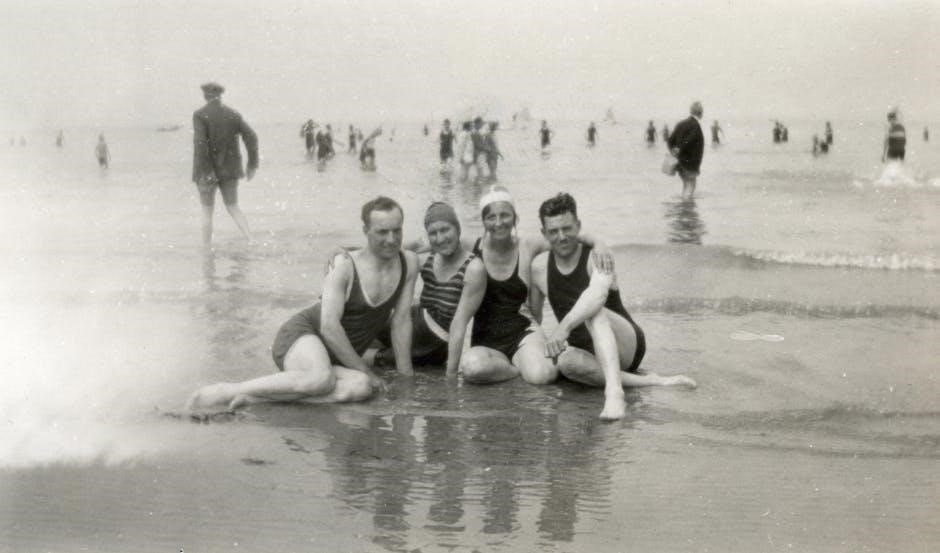Age group swim workouts are designed for young swimmers aged 6-18, focusing on improving technique and building endurance through structured drills, kicks, and main sets, incorporating fun activities.
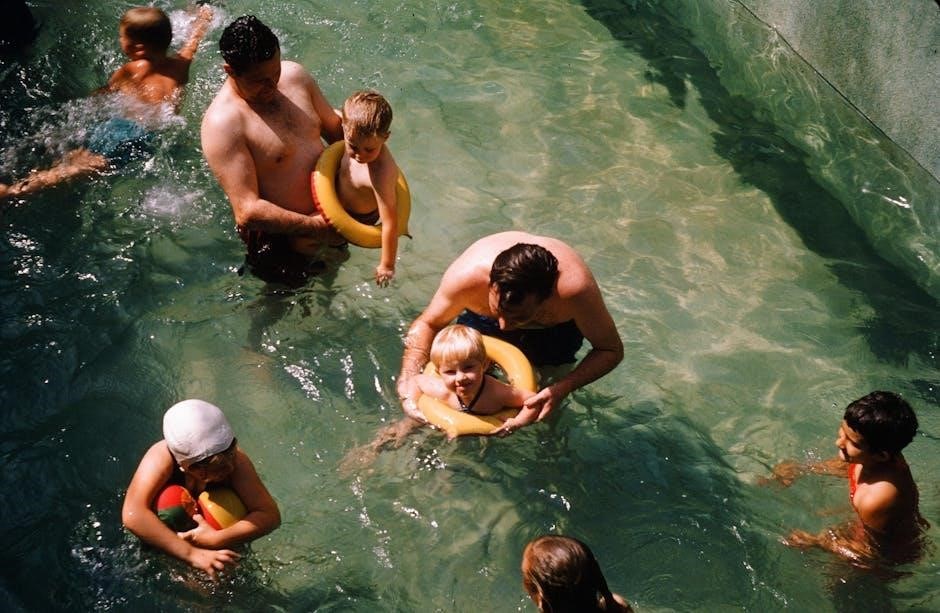
Understanding the Importance of Age Group Swim Workouts
Age group swim workouts are essential for developing young swimmers’ skills and endurance, offering structured training for ages 6-18, focusing on technique and progressive improvement in a fun environment.
Why Age Group Workouts Are Essential for Young Swimmers
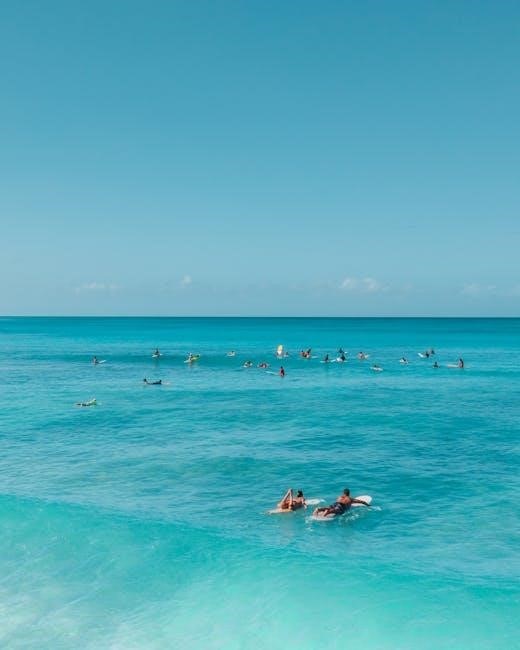
Age group workouts are vital for young swimmers as they provide structured progression, fostering skill development, physical conditioning, and technique refinement. These sessions cater to different age ranges, ensuring swimmers build endurance, strength, and coordination tailored to their growth stages. By focusing on specific drills and sets, young athletes improve stroke mechanics, reducing injury risks and enhancing performance. Age group workouts also cultivate discipline, motivation, and teamwork, essential for long-term success in swimming. The collaborative environment encourages camaraderie, helping swimmers stay engaged and committed to their training. Coaches can adapt workouts to individual needs, ensuring a balanced approach to development. Overall, age group workouts lay a strong foundation for swimmers to excel in competitions and beyond.
How Age Group Workouts Differ by Skill Level
Age group workouts vary significantly based on swimmers’ skill levels, ensuring each athlete receives appropriate challenges. For beginners, workouts focus on fundamental techniques, basic drills, and building water comfort. Intermediate swimmers engage in more complex drills, refining strokes and increasing endurance. Advanced swimmers participate in high-intensity sets, focusing on speed, power, and race-specific strategies. The structure and intensity of workouts are tailored to match the skill level, preventing plateaus and fostering continuous improvement. Coaches adapt exercises to address individual strengths and weaknesses, ensuring balanced development. This tiered approach allows swimmers to progress at their own pace, preparing them for higher levels of competition. By aligning workouts with skill levels, age group programs maximize efficiency and engagement, helping swimmers achieve their full potential.
Structure of a Typical Age Group Swim Workout
A typical age group swim workout includes warm-up, technique drills, kick sets, main sets, and cool-down. It balances technique, endurance, and speed, adapting to skill levels and age groups.
Warm-Up and Cool-Down Routines
A proper warm-up and cool-down are essential in age group swim workouts to prevent injuries and enhance performance. Warm-ups typically last 10-15 minutes, starting with light cardio such as jogging or jumping jacks, followed by dynamic stretches like arm circles and leg swings. Swimmers then transition to the water for gentle laps, focusing on technique drills to activate their muscles. Cool-downs, lasting 5-10 minutes, involve slower swimming or floating to gradually lower heart rates. Static stretches for shoulders, hamstrings, and hips are included to improve flexibility and reduce muscle tension. These routines are tailored to the age and skill level of the swimmers, ensuring a safe and effective transition into and out of intense training.
Kick Sets and Their Role in Building Endurance
Kick sets are a fundamental component of age group swim workouts, designed to enhance endurance and strengthen the lower body. These sets focus on various kicking techniques, such as the flutter, frog, and dolphin kicks, performed with or without a kickboard. By isolating the legs, swimmers build cardiovascular stamina and improve muscle endurance. Coaches often incorporate interval training within kick sets, alternating between high-intensity bursts and recovery periods to simulate race conditions. This approach not only boosts aerobic capacity but also enhances power and control in the water. Consistent practice of kick sets helps swimmers maintain a strong, efficient kick, which is critical for overall performance in races. These sets are tailored to the skill level of the group, ensuring a challenging yet effective workout for each athlete.
Drills for Technique Improvement
Drills for technique improvement are essential in age group swim workouts to refine stroke mechanics and enhance efficiency. Coaches use specific exercises like catch-up drills for freestyle, focusing on hand entry and alignment, and flip-turn drills for backstroke to improve rotation. These drills target areas such as body positioning, arm movement, and breathing. For younger swimmers, simplified drills like finger drag or closed-fist swimming help develop proper hand placement and pull technique. Older athletes benefit from advanced drills like underwater dolphin kicks and flip turns to refine their skills. Incorporating tools like kickboards, fins, and snorkels allows swimmers to isolate specific movements, ensuring precise execution. Regular technique drills foster muscle memory, leading to more efficient and effective strokes. This focus on mechanics helps swimmers perform at higher levels while reducing injury risk.
Main Sets and Their Purpose
Main sets are the core component of age group swim workouts, designed to build endurance, speed, and strength. These sets typically involve swimming longer distances or repeating shorter intervals at a high intensity. Coaches tailor main sets to the skill level and age of the swimmers, ensuring they challenge athletes without causing fatigue. For younger swimmers, main sets might focus on building stamina through continuous swimming, while older athletes engage in interval training to improve race pace. The purpose of main sets is to enhance cardiovascular fitness, muscular endurance, and race-specific skills. They often include a mix of strokes and distances to promote well-rounded development. By progressively increasing intensity and volume, main sets help swimmers achieve their seasonal goals and prepare for competitions. Proper pacing and recovery during these sets are crucial for optimal performance.
Stroke-Specific Drills and Techniques
Stroke-specific drills target technique improvement for freestyle, backstroke, breaststroke, and butterfly. These exercises enhance efficiency, rotation, streamline, and power, helping swimmers master each stroke’s unique mechanics and timing.
Freestyle Drills for Efficiency
Freestyle drills focus on optimizing technique to maximize speed and endurance. Catch-up drills improve hand entry and alignment, while finger drag exercises enhance feel for the water. Closed fist drills build forearm strength and promote a more effective pull phase. High-elbow drills ensure proper arm positioning during recovery, reducing drag and increasing efficiency. Flipper kicking emphasizes a strong, steady kick, which is essential for maintaining rhythm. Tempo sets and pacing exercises help swimmers develop consistent speed over distances. These drills collectively improve body positioning, stroke timing, and overall performance in freestyle events, making them a cornerstone of age group swim workouts.
Backstroke Drills for Better Rotation
Backstroke drills are designed to enhance body rotation, which is critical for maintaining a balanced and efficient stroke. The thumb-to-hip drill helps swimmers develop proper hand entry and body alignment. Alternating arm drills focus on timing and coordination between the arms and hips. Superman drills improve core engagement and streamline position, reducing drag. Kick-on-side exercises strengthen the kick and promote better rotation rhythm. Underwater recovery drills emphasize smooth, controlled movements during the recovery phase. These drills collectively improve body positioning, enhance rotation, and increase overall backstroke efficiency. By incorporating these techniques, young swimmers can achieve a more powerful and streamlined backstroke, essential for competitive success.
Breaststroke Drills for Streamline and Timing
Breaststroke drills focus on improving streamline and timing to maximize efficiency. The streamline push-off drill helps swimmers maintain a tight body position during starts and turns. Kicking drills with a kickboard target the whip-like motion of the breaststroke kick, emphasizing proper timing. Pulling drills without using the legs isolate the arm movement, highlighting the importance of synchronization between the arms and shoulders. The 3/4 pull drill combines arm and leg movements, reinforcing timing and coordination. Additionally, swimmers practice timing exercises with a focus on the correct sequence of the kick and pull. These drills enhance streamline, improve timing, and increase overall breaststroke efficiency, helping young swimmers master this complex stroke. Incorporating these drills into workouts ensures better performance in races and competitions.
Butterfly Drills for Power and Control
Butterfly drills are designed to enhance power and control, focusing on the stroke’s unique undulation. The dolphin kick drill isolates the kick, emphasizing a powerful, synchronized movement. Using a pull buoy, swimmers practice the arm stroke without the kick, improving timing and body position. Timing drills, such as the “catch-up” drill, focus on synchronizing arm and leg movements. Surface dives and underwater dolphin kicks build explosive power. Swimmers also practice breaking the stroke into segments, refining each part for better control. These drills help young athletes master the rhythm and strength required for butterfly, making it more efficient and effective during races. Incorporating these exercises into workouts ensures swimmers develop both power and control, essential for competitive success.

Age Group Swim Workouts for Different Age Groups
Age group swim workouts are tailored to meet the unique needs of swimmers at different stages, focusing on skill development, physical growth, and performance goals for each age category.
Workouts for 6-10 Year Olds
Swim workouts for children aged 6-10 focus on building foundational skills, water confidence, and a love for swimming. These sessions emphasize fun and engagement, blending games with technique drills. Coaches use age-appropriate exercises to develop basic strokes like freestyle and backstroke, while introducing breaststroke and butterfly in simpler forms. Kick sets are short and repetitive to improve endurance without overwhelming young athletes. Drills often incorporate pool toys or relays to maintain excitement and teamwork. Strength training is minimal, focusing instead on body positioning and coordination. Warm-ups and cool-downs are gentle, prioritizing safety and flexibility. The goal is to create a positive environment where children can progress at their own pace, fostering a lifelong passion for swimming while laying the groundwork for future competitive skills.
Workouts for 11-14 Year Olds
Swim workouts for 11-14 year olds are designed to enhance endurance, refine technique, and build strength. At this stage, swimmers have developed basic skills and can handle more structured training. Workouts often include longer sets, interval training, and stroke-specific drills to improve efficiency. Coaches focus on refining freestyle, backstroke, breaststroke, and butterfly techniques through targeted exercises. Dryland exercises may be introduced to improve flexibility and overall athletic performance. Fun activities like relay races and games are still incorporated to maintain engagement. Nutrition and recovery become more emphasized, with guidance on balanced meals and hydration. These workouts prepare young athletes for more advanced training, fostering both physical and mental development while keeping the experience enjoyable and challenging.
Workouts for 15-18 Year Olds
Swim workouts for 15-18 year olds are tailored to advanced skill levels, focusing on high-intensity training, strength building, and race strategy. These sessions often involve longer distances, sprint intervals, and specialized drills to refine stroke mechanics and increase power. Coaches emphasize mental toughness, race tactics, and efficient pacing. Dryland exercises are intensified to enhance muscular endurance and core strength. Technique refinement is crucial, with a focus on minimizing drag and maximizing efficiency in all strokes. Video analysis may be used to fine-tune performance. Nutrition and recovery strategies are prioritized to support intense training and prevent injuries. These workouts prepare athletes for high-level competitions, fostering both physical and mental resilience while maintaining a competitive edge.
Fun Activities and Games in Swim Workouts
Fun activities and games in swim workouts make practices engaging, fostering teamwork and motivation. Examples include relay races, underwater challenges, and treasure hunts, enhancing enjoyment while improving skills.
Swim Games That Enhance Technique
Swim games that enhance technique are a fun way to improve skills while keeping practices engaging. Games like “Shark and Minnow” encourage swimmers to focus on stroke efficiency and speed to avoid being caught. “Follow the Leader” can be adapted to emphasize proper body positioning and kick techniques. Other games, such as “Red Light, Green Light,” teach swimmers to control their pacing and breathing. These activities make learning enjoyable and help build muscle memory for better technique. Incorporating such games into workouts ensures young swimmers stay motivated while refining their skills in a playful environment;
- Games like “Shark and Minnow” improve stroke efficiency and speed.
- “Follow the Leader” emphasizes proper body positioning and technique.
- Activities promote muscle memory and focus on body positioning.
Relay Races and Team-Building Exercises
Relay races and team-building exercises are essential components of age group swim workouts, fostering camaraderie and healthy competition. These activities teach swimmers the importance of collaboration and accountability, as each member’s performance directly impacts the team’s success. Coaches often organize relays like 4×50 freestyle or medley relays to challenge swimmers and encourage strategic thinking about race dynamics. Team-building exercises, such as synchronised swimming routines or water polo games, promote communication and trust among athletes. These exercises not only enhance physical skills but also prepare young swimmers for the mental and emotional demands of competitive swimming. By fostering a sense of unity, relay races and team-building exercises create a supportive environment that is crucial for long-term development.
- Relays like 4×50 freestyle or medley races challenge swimmers and promote strategic thinking.
- Team-building exercises, such as water polo or synchronised swimming, enhance communication and trust.
- These activities prepare swimmers for the mental and emotional demands of competitive swimming.

Dryland Training and Its Benefits
Dryland training is crucial for swimmers, enhancing strength, flexibility, and injury prevention through targeted exercises. It complements water-based workouts, improving overall performance and endurance.

Dryland Exercises for Strength and Flexibility
Dryland exercises are essential for building strength, flexibility, and overall athleticism in young swimmers. These workouts often include bodyweight exercises like push-ups, squats, and planks, which target core and upper body muscles. Resistance bands or light weights can enhance strength training. Flexibility exercises, such as dynamic stretches and yoga poses, improve range of motion and reduce injury risk. Exercises like lunges and step-ups focus on leg strength, crucial for powerful kicks in the water. Additionally, medicine ball throws and plyometric drills improve explosive power, benefiting starts and turns. These exercises are tailored to age and skill level, ensuring safe and effective progress. By incorporating dryland routines, swimmers can develop a stronger, more balanced physique, leading to better performance in the pool.
Dynamic Stretching and Warm-Up Routines
Dynamic stretching and warm-up routines are vital for preparing young swimmers for effective training; These exercises involve active movements, such as arm circles, leg swings, and torso twists, which help increase blood flow and flexibility. Unlike static stretches, dynamic stretches mimic swimming motions, making them more sport-specific. A proper warm-up also includes light cardio, such as jumping jacks or jogging, to elevate heart rates and prepare muscles for exertion. These routines reduce the risk of injury by gradually increasing muscle temperature and joint mobility. Additionally, they mentally prepare swimmers for the upcoming workout, fostering focus and readiness. Coaches often tailor warm-ups to the day’s training focus, ensuring swimmers are optimally prepared for drills or high-intensity sets. A well-structured warm-up is a cornerstone of age group swim workouts, promoting both performance and safety.
Nutrition and Recovery for Young Swimmers
Proper nutrition and recovery are crucial for young swimmers to optimize performance, support growth, and prevent fatigue. Balanced diets, hydration, and rest are essential for muscle repair and energy replenishment, fostering long-term success in the sport.
Importance of Proper Nutrition
Proper nutrition plays a vital role in the performance, growth, and overall health of young swimmers. A balanced diet provides the necessary energy for intense workouts, aids in muscle recovery, and supports growth and development. Swimmers require adequate carbohydrates for energy, lean proteins to repair and build muscles, and healthy fats for essential nutrients. Hydration is also crucial, as water loss through sweat can impair performance. Timing meals and snacks around practice and competitions ensures optimal energy levels. A well-planned diet helps prevent fatigue, reduces injury risk, and enhances recovery. Additionally, avoiding unhealthy snacks and focusing on nutrient-dense foods supports long-term health and athletic success. Proper nutrition is a cornerstone of age group swim workouts, enabling young athletes to train effectively and reach their full potential in the pool.
Recovery Techniques for Young Athletes
Recovery is essential for young swimmers to repair muscles, prevent injuries, and maintain performance. Techniques such as stretching, foam rolling, and light swimming after workouts can improve flexibility and reduce muscle soreness. Ice baths or cold-water therapy are effective for reducing inflammation and speeding up recovery. Compression garments and elevation of limbs can also aid in reducing muscle swelling. Additionally, sleep is a critical recovery tool, with 8-10 hours recommended for young athletes to support growth and tissue repair. Hydration and gentle movement, such as walking or yoga, further enhance recovery. Incorporating these practices helps swimmers return to training stronger and more resilient, ensuring long-term success in age group swim workouts.
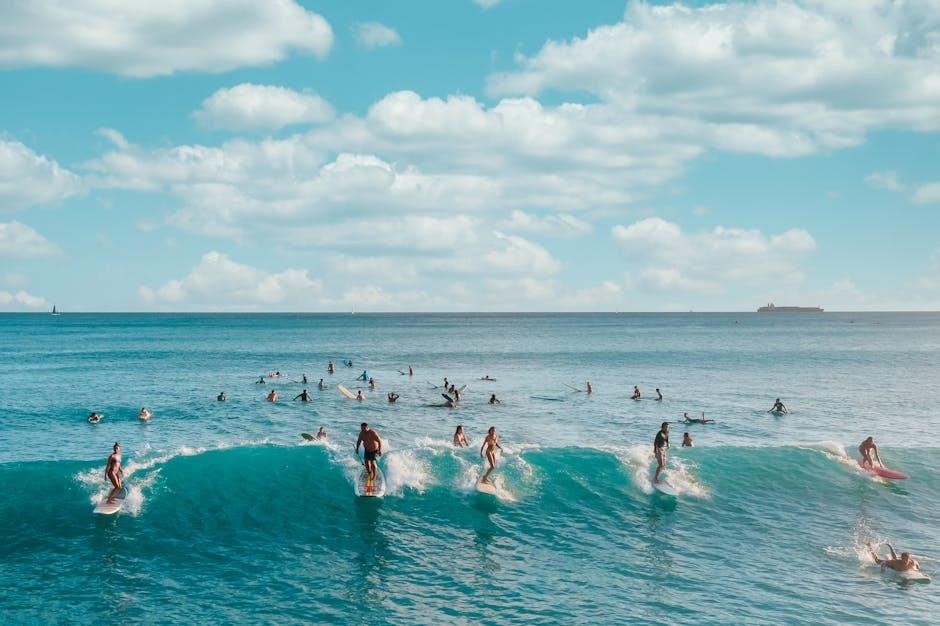
Using Technology in Swim Workouts
Technology enhances swim training through tools like swim watches, underwater cameras, and mobile apps, providing real-time feedback on performance, stroke analysis, and pacing, optimizing efficiency and engagement for young athletes.
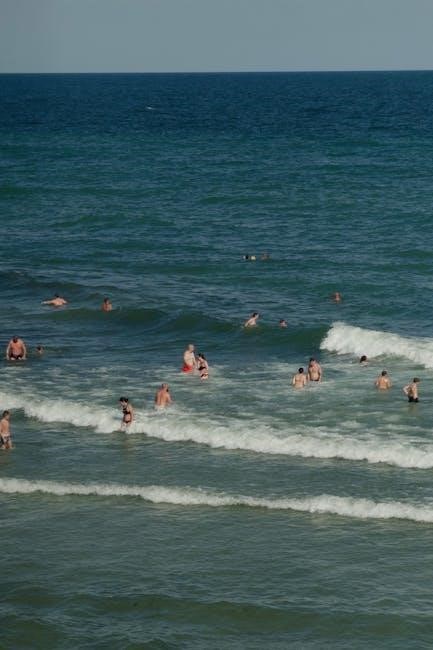
Snorkels and Fins for Enhanced Training
Snorkels and fins are invaluable tools in age group swim workouts, aiding young athletes in refining technique and building endurance. Snorkels allow swimmers to focus on their stroke mechanics without breaking rhythm for breath, enhancing body positioning and streamlining. Fins, particularly kick fins, strengthen leg muscles and improve kick efficiency, benefiting strokes like freestyle and backstroke. They also enable swimmers to maintain higher speeds during drills, promoting cardiovascular fitness. Coaches often incorporate snorkels and fins into sets to isolate specific skills, such as arm technique or kick timing, while reducing fatigue. These tools not only accelerate skill development but also keep workouts engaging and challenging for young swimmers. Proper use of snorkels and fins can elevate the effectiveness of age group training programs, fostering faster progress and better overall performance in competitions.
Video Analysis for Technique Improvement
Video analysis is a powerful tool for refining swimming techniques in age group workouts. By recording swimmers during practice, coaches can provide detailed feedback on body positioning, stroke mechanics, and timing. This visual feedback helps young athletes identify and correct flaws they may not feel while swimming. Slow-motion replays are particularly useful for analyzing complex movements, such as butterfly or breaststroke. Coaches can also compare a swimmer’s technique to that of elite athletes, setting clear benchmarks for improvement. Additionally, video analysis can boost confidence by showing progress over time. When integrated into regular training, this technology enhances learning, accelerates skill development, and ensures swimmers build efficient habits from a young age. It’s a valuable resource for fostering long-term improvement in age group swim workouts.
Creating a Seasonal Training Plan

A well-structured seasonal plan balances endurance, technique, and strength, ensuring progressive skill development and peak performance during key competitions, fostering long-term success for young swimmers.
Periodization in Age Group Training
Periodization in age group training involves structuring the season into specific phases, each with distinct goals. This approach balances endurance, speed, and technique development, ensuring young swimmers peak for major competitions. By dividing the season into macrocycles (e.g., preparatory, competitive, and recovery phases), coaches can progressively build skills and fitness. Each phase focuses on different aspects, such as building a foundation of endurance in the preseason or refining race strategies during the competitive period. Proper periodization prevents burnout by alternating intense training with recovery, allowing swimmers to adapt and improve consistently. It also aligns with the physical and emotional development of young athletes, making it a cornerstone of effective age group swim workouts. This method ensures sustained progress and long-term success in the sport.
Setting Goals for Each Training Phase
Setting specific goals for each training phase is crucial for young swimmers to stay motivated and track progress. These goals should align with the swimmer’s abilities and the objectives of the current phase. For example, during the preseason, focus on building endurance and technique, while in-season goals might emphasize race strategy and speed. Postseason goals could include maintaining fitness and recovering. Coaches and swimmers should collaborate to define short-term and long-term targets, ensuring they are measurable and achievable. Regular assessments help adjust goals as needed, keeping swimmers engaged and focused. Tailoring goals to individual needs ensures a personalized approach, fostering growth and confidence. This structured goal-setting process is essential for maximizing the effectiveness of age group swim workouts and promoting long-term development in young athletes.
